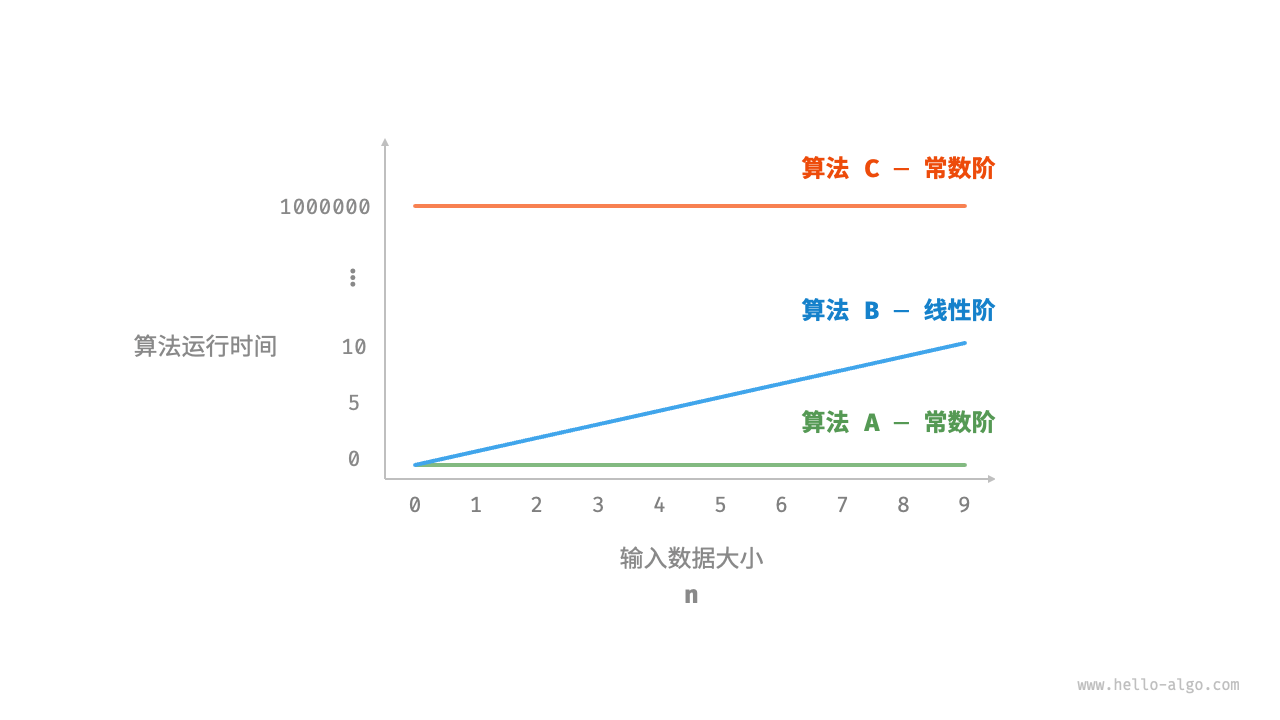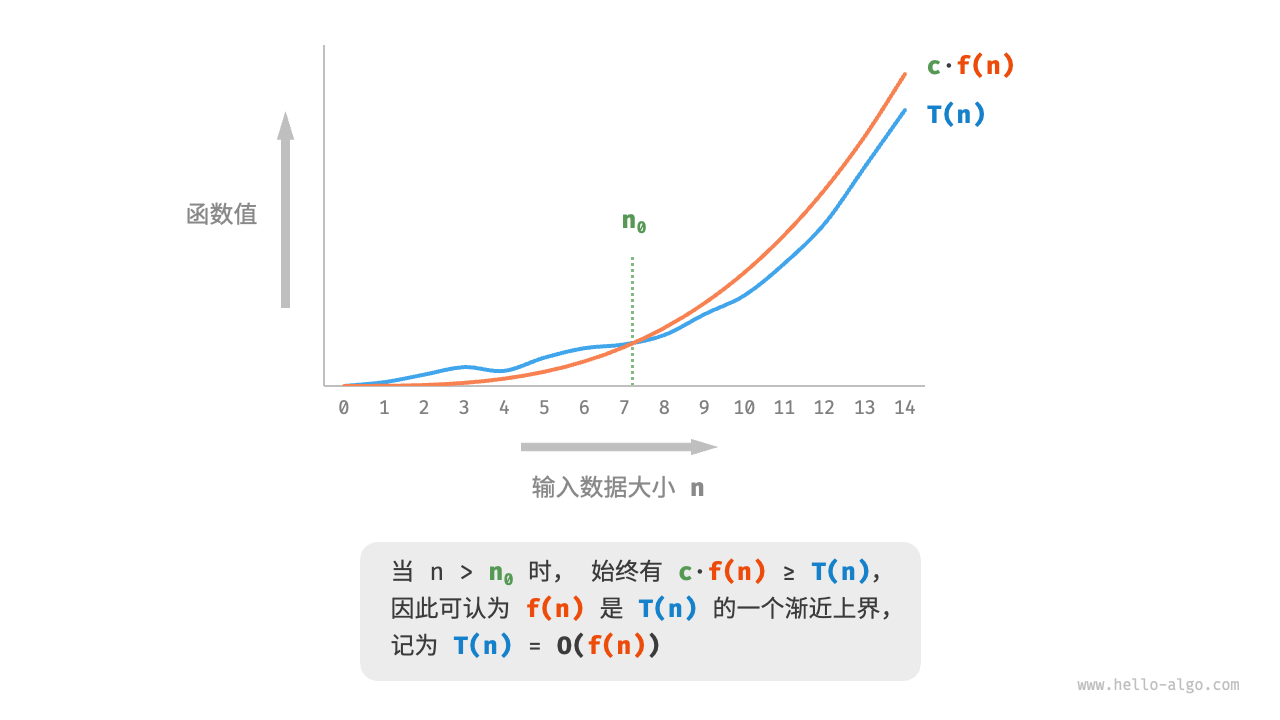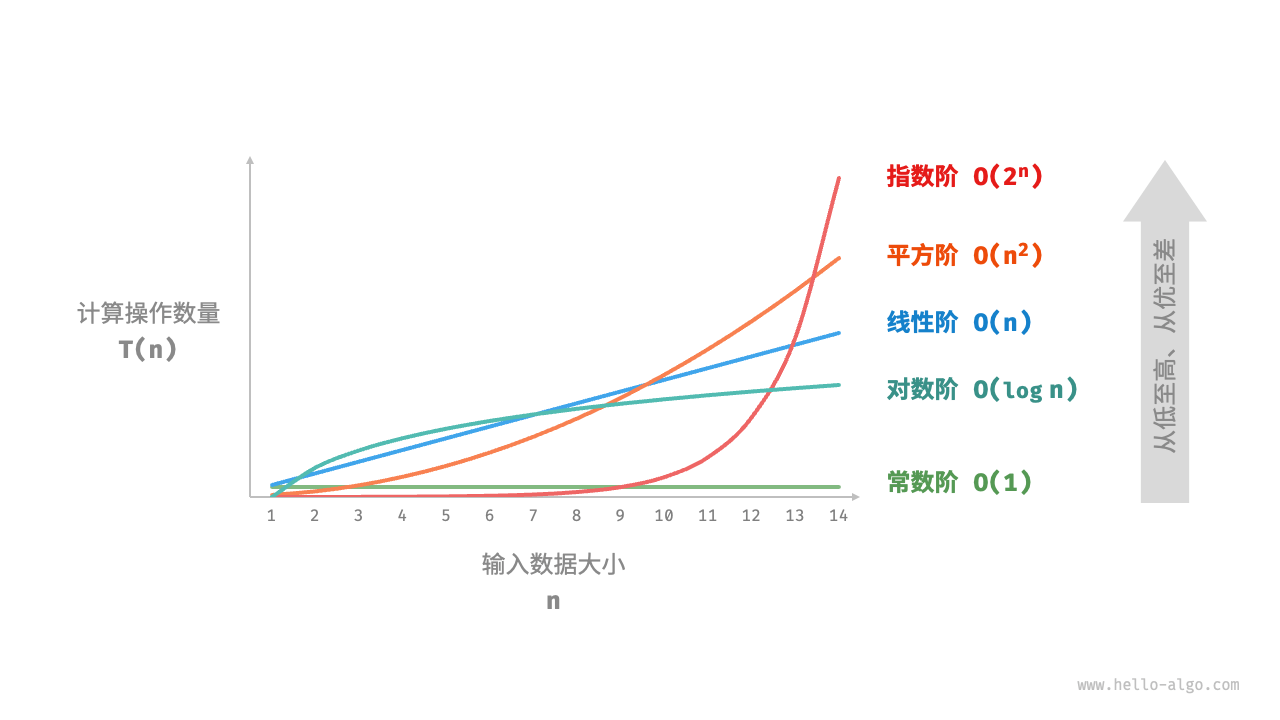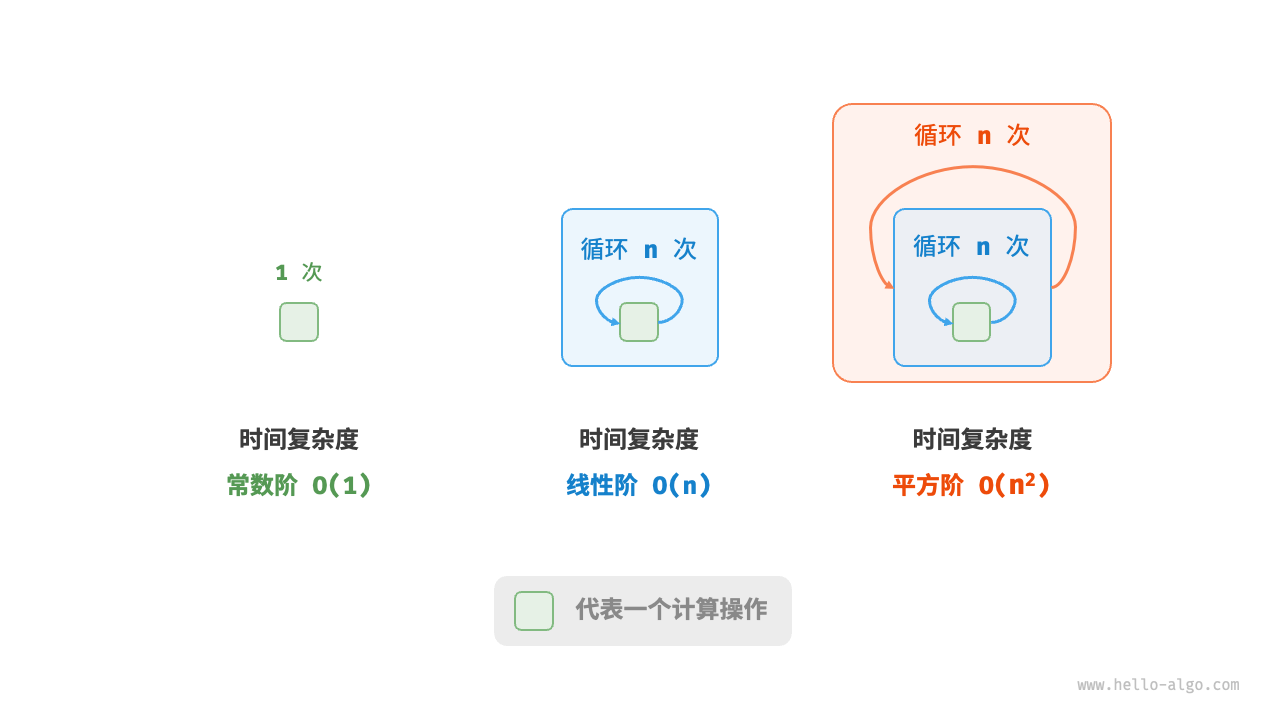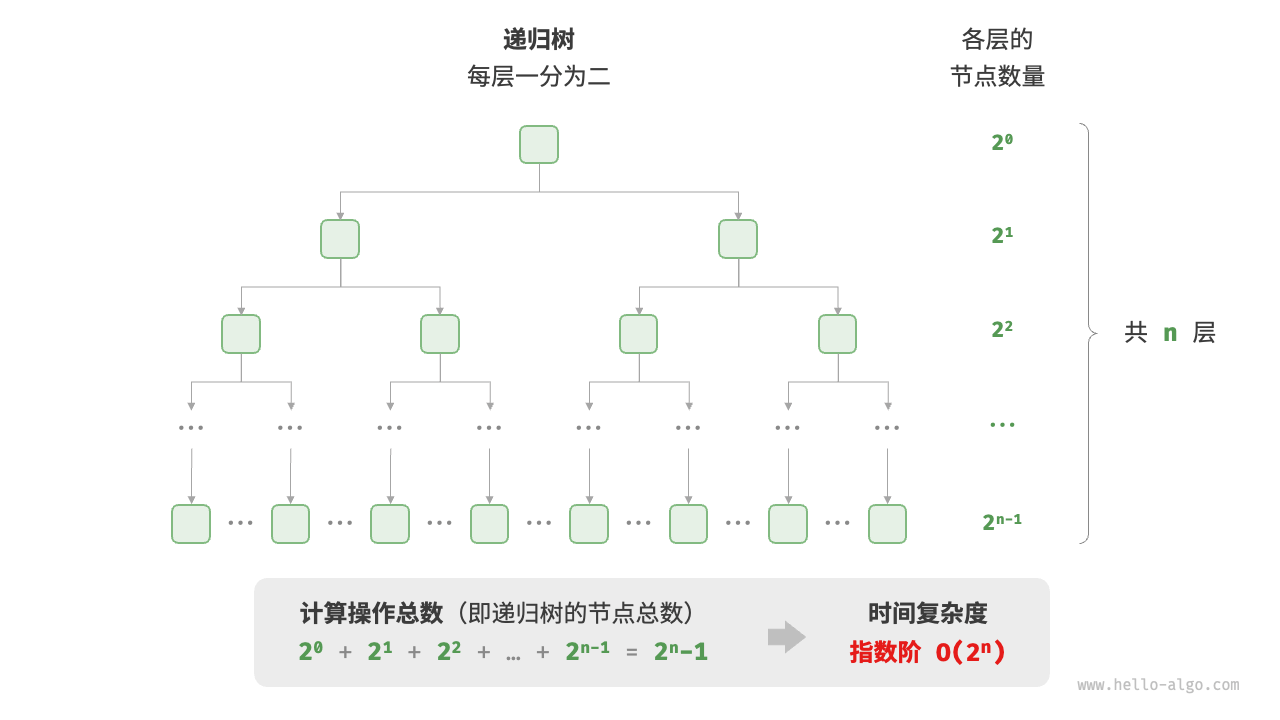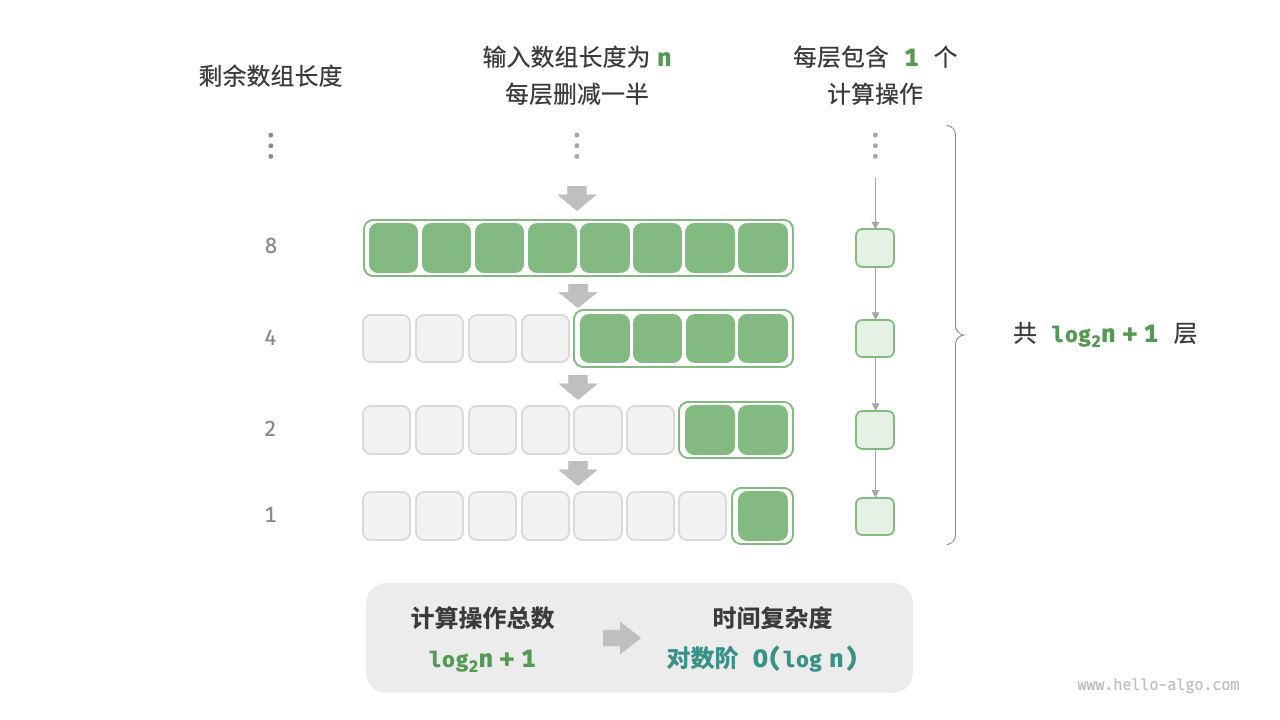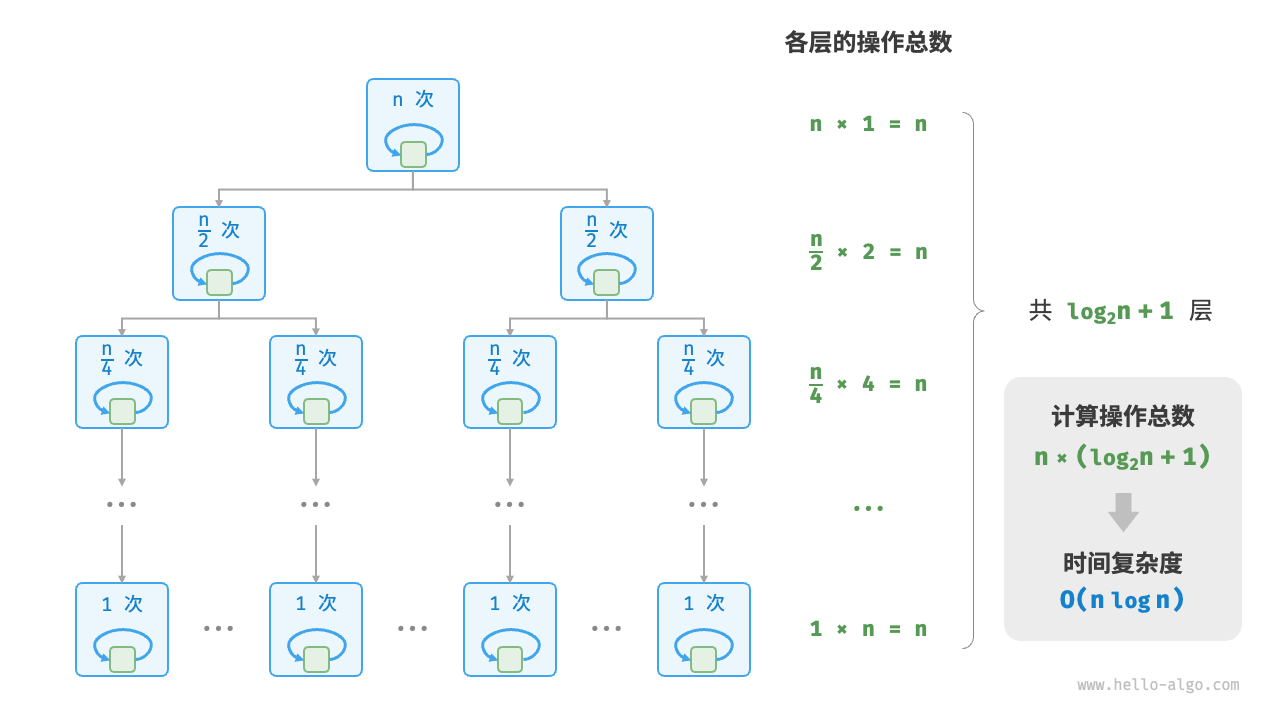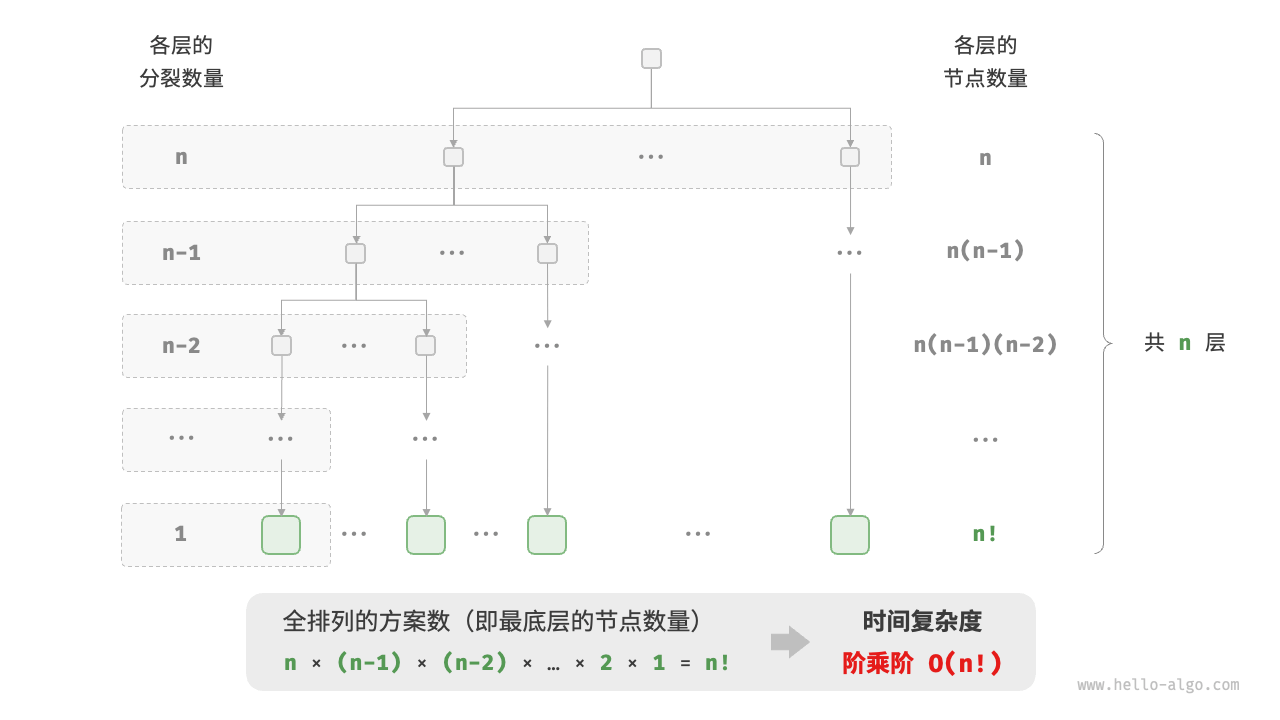2.3 时间复杂度¶
运行时间可以直观且准确地反映算法的效率。如果我们想准确预估一段代码的运行时间,应该如何操作呢?
- 确定运行平台,包括硬件配置、编程语言、系统环境等,这些因素都会影响代码的运行效率。
- 评估各种计算操作所需的运行时间,例如加法操作
+需要 1 ns ,乘法操作*需要 10 ns ,打印操作print()需要 5 ns 等。 - 统计代码中所有的计算操作,并将所有操作的执行时间求和,从而得到运行时间。
例如在以下代码中,输入数据大小为 \(n\) :
根据以上方法,可以得到算法的运行时间为 \((6n + 12)\) ns :
但实际上,统计算法的运行时间既不合理也不现实。首先,我们不希望将预估时间和运行平台绑定,因为算法需要在各种不同的平台上运行。其次,我们很难获知每种操作的运行时间,这给预估过程带来了极大的难度。
2.3.1 统计时间增长趋势¶
时间复杂度分析统计的不是算法运行时间,而是算法运行时间随着数据量变大时的增长趋势。
“时间增长趋势”这个概念比较抽象,我们通过一个例子来加以理解。假设输入数据大小为 \(n\) ,给定三个算法 A、B 和 C :
// 算法 A 的时间复杂度:常数阶
function algorithm_A(n: number): void {
console.log(0);
}
// 算法 B 的时间复杂度:线性阶
function algorithm_B(n: number): void {
for (let i = 0; i < n; i++) {
console.log(0);
}
}
// 算法 C 的时间复杂度:常数阶
function algorithm_C(n: number): void {
for (let i = 0; i < 1000000; i++) {
console.log(0);
}
}
// 算法 A 的时间复杂度:常数阶
fn algorithm_A(n: usize) void {
_ = n;
std.debug.print("{}\n", .{0});
}
// 算法 B 的时间复杂度:线性阶
fn algorithm_B(n: i32) void {
for (0..n) |_| {
std.debug.print("{}\n", .{0});
}
}
// 算法 C 的时间复杂度:常数阶
fn algorithm_C(n: i32) void {
_ = n;
for (0..1000000) |_| {
std.debug.print("{}\n", .{0});
}
}
图 2-7 展示了以上三个算法函数的时间复杂度。
- 算法
A只有 \(1\) 个打印操作,算法运行时间不随着 \(n\) 增大而增长。我们称此算法的时间复杂度为“常数阶”。 - 算法
B中的打印操作需要循环 \(n\) 次,算法运行时间随着 \(n\) 增大呈线性增长。此算法的时间复杂度被称为“线性阶”。 - 算法
C中的打印操作需要循环 \(1000000\) 次,虽然运行时间很长,但它与输入数据大小 \(n\) 无关。因此C的时间复杂度和A相同,仍为“常数阶”。
图 2-7 算法 A、B 和 C 的时间增长趋势
相较于直接统计算法的运行时间,时间复杂度分析有哪些特点呢?
- 时间复杂度能够有效评估算法效率。例如,算法
B的运行时间呈线性增长,在 \(n > 1\) 时比算法A更慢,在 \(n > 1000000\) 时比算法C更慢。事实上,只要输入数据大小 \(n\) 足够大,复杂度为“常数阶”的算法一定优于“线性阶”的算法,这正是时间增长趋势的含义。 - 时间复杂度的推算方法更简便。显然,运行平台和计算操作类型都与算法运行时间的增长趋势无关。因此在时间复杂度分析中,我们可以简单地将所有计算操作的执行时间视为相同的“单位时间”,从而将“计算操作运行时间统计”简化为“计算操作数量统计”,这样一来估算难度就大大降低了。
- 时间复杂度也存在一定的局限性。例如,尽管算法
A和C的时间复杂度相同,但实际运行时间差别很大。同样,尽管算法B的时间复杂度比C高,但在输入数据大小 \(n\) 较小时,算法B明显优于算法C。对于此类情况,我们时常难以仅凭时间复杂度判断算法效率的高低。当然,尽管存在上述问题,复杂度分析仍然是评判算法效率最有效且常用的方法。
2.3.2 函数渐近上界¶
给定一个输入大小为 \(n\) 的函数:
设算法的操作数量是一个关于输入数据大小 \(n\) 的函数,记为 \(T(n)\) ,则以上函数的操作数量为:
\(T(n)\) 是一次函数,说明其运行时间的增长趋势是线性的,因此它的时间复杂度是线性阶。
我们将线性阶的时间复杂度记为 \(O(n)\) ,这个数学符号称为大 \(O\) 记号(big-\(O\) notation),表示函数 \(T(n)\) 的渐近上界(asymptotic upper bound)。
时间复杂度分析本质上是计算“操作数量 \(T(n)\)”的渐近上界,它具有明确的数学定义。
函数渐近上界
若存在正实数 \(c\) 和实数 \(n_0\) ,使得对于所有的 \(n > n_0\) ,均有 \(T(n) \leq c \cdot f(n)\) ,则可认为 \(f(n)\) 给出了 \(T(n)\) 的一个渐近上界,记为 \(T(n) = O(f(n))\) 。
如图 2-8 所示,计算渐近上界就是寻找一个函数 \(f(n)\) ,使得当 \(n\) 趋向于无穷大时,\(T(n)\) 和 \(f(n)\) 处于相同的增长级别,仅相差一个常数项 \(c\) 的倍数。
图 2-8 函数的渐近上界
2.3.3 推算方法¶
渐近上界的数学味儿有点重,如果你感觉没有完全理解,也无须担心。我们可以先掌握推算方法,在不断的实践中,就可以逐渐领悟其数学意义。
根据定义,确定 \(f(n)\) 之后,我们便可得到时间复杂度 \(O(f(n))\) 。那么如何确定渐近上界 \(f(n)\) 呢?总体分为两步:首先统计操作数量,然后判断渐近上界。
1. 第一步:统计操作数量¶
针对代码,逐行从上到下计算即可。然而,由于上述 \(c \cdot f(n)\) 中的常数项 \(c\) 可以取任意大小,因此操作数量 \(T(n)\) 中的各种系数、常数项都可以忽略。根据此原则,可以总结出以下计数简化技巧。
- 忽略 \(T(n)\) 中的常数项。因为它们都与 \(n\) 无关,所以对时间复杂度不产生影响。
- 省略所有系数。例如,循环 \(2n\) 次、\(5n + 1\) 次等,都可以简化记为 \(n\) 次,因为 \(n\) 前面的系数对时间复杂度没有影响。
- 循环嵌套时使用乘法。总操作数量等于外层循环和内层循环操作数量之积,每一层循环依然可以分别套用第
1.点和第2.点的技巧。
给定一个函数,我们可以用上述技巧来统计操作数量:
以下公式展示了使用上述技巧前后的统计结果,两者推算出的时间复杂度都为 \(O(n^2)\) 。
2. 第二步:判断渐近上界¶
时间复杂度由 \(T(n)\) 中最高阶的项来决定。这是因为在 \(n\) 趋于无穷大时,最高阶的项将发挥主导作用,其他项的影响都可以忽略。
表 2-2 展示了一些例子,其中一些夸张的值是为了强调“系数无法撼动阶数”这一结论。当 \(n\) 趋于无穷大时,这些常数变得无足轻重。
表 2-2 不同操作数量对应的时间复杂度
| 操作数量 \(T(n)\) | 时间复杂度 \(O(f(n))\) |
|---|---|
| \(100000\) | \(O(1)\) |
| \(3n + 2\) | \(O(n)\) |
| \(2n^2 + 3n + 2\) | \(O(n^2)\) |
| \(n^3 + 10000n^2\) | \(O(n^3)\) |
| \(2^n + 10000n^{10000}\) | \(O(2^n)\) |
2.3.4 常见类型¶
设输入数据大小为 \(n\) ,常见的时间复杂度类型如图 2-9 所示(按照从低到高的顺序排列)。
图 2-9 常见的时间复杂度类型
1. 常数阶 \(O(1)\)¶
常数阶的操作数量与输入数据大小 \(n\) 无关,即不随着 \(n\) 的变化而变化。
在以下函数中,尽管操作数量 size 可能很大,但由于其与输入数据大小 \(n\) 无关,因此时间复杂度仍为 \(O(1)\) :
可视化运行
2. 线性阶 \(O(n)\)¶
线性阶的操作数量相对于输入数据大小 \(n\) 以线性级别增长。线性阶通常出现在单层循环中:
可视化运行
遍历数组和遍历链表等操作的时间复杂度均为 \(O(n)\) ,其中 \(n\) 为数组或链表的长度:
可视化运行
值得注意的是,输入数据大小 \(n\) 需根据输入数据的类型来具体确定。比如在第一个示例中,变量 \(n\) 为输入数据大小;在第二个示例中,数组长度 \(n\) 为数据大小。
3. 平方阶 \(O(n^2)\)¶
平方阶的操作数量相对于输入数据大小 \(n\) 以平方级别增长。平方阶通常出现在嵌套循环中,外层循环和内层循环的时间复杂度都为 \(O(n)\) ,因此总体的时间复杂度为 \(O(n^2)\) :
可视化运行
图 2-10 对比了常数阶、线性阶和平方阶三种时间复杂度。
图 2-10 常数阶、线性阶和平方阶的时间复杂度
以冒泡排序为例,外层循环执行 \(n - 1\) 次,内层循环执行 \(n-1\)、\(n-2\)、\(\dots\)、\(2\)、\(1\) 次,平均为 \(n / 2\) 次,因此时间复杂度为 \(O((n - 1) n / 2) = O(n^2)\) :
def bubble_sort(nums: list[int]) -> int:
"""平方阶(冒泡排序)"""
count = 0 # 计数器
# 外循环:未排序区间为 [0, i]
for i in range(len(nums) - 1, 0, -1):
# 内循环:将未排序区间 [0, i] 中的最大元素交换至该区间的最右端
for j in range(i):
if nums[j] > nums[j + 1]:
# 交换 nums[j] 与 nums[j + 1]
tmp: int = nums[j]
nums[j] = nums[j + 1]
nums[j + 1] = tmp
count += 3 # 元素交换包含 3 个单元操作
return count
/* 平方阶(冒泡排序) */
int bubbleSort(vector<int> &nums) {
int count = 0; // 计数器
// 外循环:未排序区间为 [0, i]
for (int i = nums.size() - 1; i > 0; i--) {
// 内循环:将未排序区间 [0, i] 中的最大元素交换至该区间的最右端
for (int j = 0; j < i; j++) {
if (nums[j] > nums[j + 1]) {
// 交换 nums[j] 与 nums[j + 1]
int tmp = nums[j];
nums[j] = nums[j + 1];
nums[j + 1] = tmp;
count += 3; // 元素交换包含 3 个单元操作
}
}
}
return count;
}
/* 平方阶(冒泡排序) */
int bubbleSort(int[] nums) {
int count = 0; // 计数器
// 外循环:未排序区间为 [0, i]
for (int i = nums.length - 1; i > 0; i--) {
// 内循环:将未排序区间 [0, i] 中的最大元素交换至该区间的最右端
for (int j = 0; j < i; j++) {
if (nums[j] > nums[j + 1]) {
// 交换 nums[j] 与 nums[j + 1]
int tmp = nums[j];
nums[j] = nums[j + 1];
nums[j + 1] = tmp;
count += 3; // 元素交换包含 3 个单元操作
}
}
}
return count;
}
/* 平方阶(冒泡排序) */
int BubbleSort(int[] nums) {
int count = 0; // 计数器
// 外循环:未排序区间为 [0, i]
for (int i = nums.Length - 1; i > 0; i--) {
// 内循环:将未排序区间 [0, i] 中的最大元素交换至该区间的最右端
for (int j = 0; j < i; j++) {
if (nums[j] > nums[j + 1]) {
// 交换 nums[j] 与 nums[j + 1]
(nums[j + 1], nums[j]) = (nums[j], nums[j + 1]);
count += 3; // 元素交换包含 3 个单元操作
}
}
}
return count;
}
/* 平方阶(冒泡排序) */
func bubbleSort(nums []int) int {
count := 0 // 计数器
// 外循环:未排序区间为 [0, i]
for i := len(nums) - 1; i > 0; i-- {
// 内循环:将未排序区间 [0, i] 中的最大元素交换至该区间的最右端
for j := 0; j < i; j++ {
if nums[j] > nums[j+1] {
// 交换 nums[j] 与 nums[j + 1]
tmp := nums[j]
nums[j] = nums[j+1]
nums[j+1] = tmp
count += 3 // 元素交换包含 3 个单元操作
}
}
}
return count
}
/* 平方阶(冒泡排序) */
func bubbleSort(nums: inout [Int]) -> Int {
var count = 0 // 计数器
// 外循环:未排序区间为 [0, i]
for i in nums.indices.dropFirst().reversed() {
// 内循环:将未排序区间 [0, i] 中的最大元素交换至该区间的最右端
for j in 0 ..< i {
if nums[j] > nums[j + 1] {
// 交换 nums[j] 与 nums[j + 1]
let tmp = nums[j]
nums[j] = nums[j + 1]
nums[j + 1] = tmp
count += 3 // 元素交换包含 3 个单元操作
}
}
}
return count
}
/* 平方阶(冒泡排序) */
function bubbleSort(nums) {
let count = 0; // 计数器
// 外循环:未排序区间为 [0, i]
for (let i = nums.length - 1; i > 0; i--) {
// 内循环:将未排序区间 [0, i] 中的最大元素交换至该区间的最右端
for (let j = 0; j < i; j++) {
if (nums[j] > nums[j + 1]) {
// 交换 nums[j] 与 nums[j + 1]
let tmp = nums[j];
nums[j] = nums[j + 1];
nums[j + 1] = tmp;
count += 3; // 元素交换包含 3 个单元操作
}
}
}
return count;
}
/* 平方阶(冒泡排序) */
function bubbleSort(nums: number[]): number {
let count = 0; // 计数器
// 外循环:未排序区间为 [0, i]
for (let i = nums.length - 1; i > 0; i--) {
// 内循环:将未排序区间 [0, i] 中的最大元素交换至该区间的最右端
for (let j = 0; j < i; j++) {
if (nums[j] > nums[j + 1]) {
// 交换 nums[j] 与 nums[j + 1]
let tmp = nums[j];
nums[j] = nums[j + 1];
nums[j + 1] = tmp;
count += 3; // 元素交换包含 3 个单元操作
}
}
}
return count;
}
/* 平方阶(冒泡排序) */
int bubbleSort(List<int> nums) {
int count = 0; // 计数器
// 外循环:未排序区间为 [0, i]
for (var i = nums.length - 1; i > 0; i--) {
// 内循环:将未排序区间 [0, i] 中的最大元素交换至该区间的最右端
for (var j = 0; j < i; j++) {
if (nums[j] > nums[j + 1]) {
// 交换 nums[j] 与 nums[j + 1]
int tmp = nums[j];
nums[j] = nums[j + 1];
nums[j + 1] = tmp;
count += 3; // 元素交换包含 3 个单元操作
}
}
}
return count;
}
/* 平方阶(冒泡排序) */
fn bubble_sort(nums: &mut [i32]) -> i32 {
let mut count = 0; // 计数器
// 外循环:未排序区间为 [0, i]
for i in (1..nums.len()).rev() {
// 内循环:将未排序区间 [0, i] 中的最大元素交换至该区间的最右端
for j in 0..i {
if nums[j] > nums[j + 1] {
// 交换 nums[j] 与 nums[j + 1]
let tmp = nums[j];
nums[j] = nums[j + 1];
nums[j + 1] = tmp;
count += 3; // 元素交换包含 3 个单元操作
}
}
}
count
}
/* 平方阶(冒泡排序) */
int bubbleSort(int *nums, int n) {
int count = 0; // 计数器
// 外循环:未排序区间为 [0, i]
for (int i = n - 1; i > 0; i--) {
// 内循环:将未排序区间 [0, i] 中的最大元素交换至该区间的最右端
for (int j = 0; j < i; j++) {
if (nums[j] > nums[j + 1]) {
// 交换 nums[j] 与 nums[j + 1]
int tmp = nums[j];
nums[j] = nums[j + 1];
nums[j + 1] = tmp;
count += 3; // 元素交换包含 3 个单元操作
}
}
}
return count;
}
/* 平方阶(冒泡排序) */
fun bubbleSort(nums: IntArray): Int {
var count = 0 // 计数器
// 外循环:未排序区间为 [0, i]
for (i in nums.size - 1 downTo 1) {
// 内循环:将未排序区间 [0, i] 中的最大元素交换至该区间的最右端
for (j in 0..<i) {
if (nums[j] > nums[j + 1]) {
// 交换 nums[j] 与 nums[j + 1]
val temp = nums[j]
nums[j] = nums[j + 1]
nums[j + 1] = temp
count += 3 // 元素交换包含 3 个单元操作
}
}
}
return count
}
### 平方阶(冒泡排序)###
def bubble_sort(nums)
count = 0 # 计数器
# 外循环:未排序区间为 [0, i]
for i in (nums.length - 1).downto(0)
# 内循环:将未排序区间 [0, i] 中的最大元素交换至该区间的最右端
for j in 0...i
if nums[j] > nums[j + 1]
# 交换 nums[j] 与 nums[j + 1]
tmp = nums[j]
nums[j] = nums[j + 1]
nums[j + 1] = tmp
count += 3 # 元素交换包含 3 个单元操作
end
end
end
count
end
// 平方阶(冒泡排序)
fn bubbleSort(nums: []i32) i32 {
var count: i32 = 0; // 计数器
// 外循环:未排序区间为 [0, i]
var i: i32 = @as(i32, @intCast(nums.len)) - 1;
while (i > 0) : (i -= 1) {
var j: usize = 0;
// 内循环:将未排序区间 [0, i] 中的最大元素交换至该区间的最右端
while (j < i) : (j += 1) {
if (nums[j] > nums[j + 1]) {
// 交换 nums[j] 与 nums[j + 1]
var tmp = nums[j];
nums[j] = nums[j + 1];
nums[j + 1] = tmp;
count += 3; // 元素交换包含 3 个单元操作
}
}
}
return count;
}
可视化运行
4. 指数阶 \(O(2^n)\)¶
生物学的“细胞分裂”是指数阶增长的典型例子:初始状态为 \(1\) 个细胞,分裂一轮后变为 \(2\) 个,分裂两轮后变为 \(4\) 个,以此类推,分裂 \(n\) 轮后有 \(2^n\) 个细胞。
图 2-11 和以下代码模拟了细胞分裂的过程,时间复杂度为 \(O(2^n)\) :
// 指数阶(循环实现)
fn exponential(n: i32) i32 {
var count: i32 = 0;
var bas: i32 = 1;
var i: i32 = 0;
// 细胞每轮一分为二,形成数列 1, 2, 4, 8, ..., 2^(n-1)
while (i < n) : (i += 1) {
var j: i32 = 0;
while (j < bas) : (j += 1) {
count += 1;
}
bas *= 2;
}
// count = 1 + 2 + 4 + 8 + .. + 2^(n-1) = 2^n - 1
return count;
}
可视化运行
图 2-11 指数阶的时间复杂度
在实际算法中,指数阶常出现于递归函数中。例如在以下代码中,其递归地一分为二,经过 \(n\) 次分裂后停止:
可视化运行
指数阶增长非常迅速,在穷举法(暴力搜索、回溯等)中比较常见。对于数据规模较大的问题,指数阶是不可接受的,通常需要使用动态规划或贪心算法等来解决。
5. 对数阶 \(O(\log n)\)¶
与指数阶相反,对数阶反映了“每轮缩减到一半”的情况。设输入数据大小为 \(n\) ,由于每轮缩减到一半,因此循环次数是 \(\log_2 n\) ,即 \(2^n\) 的反函数。
图 2-12 和以下代码模拟了“每轮缩减到一半”的过程,时间复杂度为 \(O(\log_2 n)\) ,简记为 \(O(\log n)\) :
可视化运行
图 2-12 对数阶的时间复杂度
与指数阶类似,对数阶也常出现于递归函数中。以下代码形成了一棵高度为 \(\log_2 n\) 的递归树:
可视化运行
对数阶常出现于基于分治策略的算法中,体现了“一分为多”和“化繁为简”的算法思想。它增长缓慢,是仅次于常数阶的理想的时间复杂度。
\(O(\log n)\) 的底数是多少?
准确来说,“一分为 \(m\)”对应的时间复杂度是 \(O(\log_m n)\) 。而通过对数换底公式,我们可以得到具有不同底数、相等的时间复杂度:
也就是说,底数 \(m\) 可以在不影响复杂度的前提下转换。因此我们通常会省略底数 \(m\) ,将对数阶直接记为 \(O(\log n)\) 。
6. 线性对数阶 \(O(n \log n)\)¶
线性对数阶常出现于嵌套循环中,两层循环的时间复杂度分别为 \(O(\log n)\) 和 \(O(n)\) 。相关代码如下:
可视化运行
图 2-13 展示了线性对数阶的生成方式。二叉树的每一层的操作总数都为 \(n\) ,树共有 \(\log_2 n + 1\) 层,因此时间复杂度为 \(O(n \log n)\) 。
图 2-13 线性对数阶的时间复杂度
主流排序算法的时间复杂度通常为 \(O(n \log n)\) ,例如快速排序、归并排序、堆排序等。
7. 阶乘阶 \(O(n!)\)¶
阶乘阶对应数学上的“全排列”问题。给定 \(n\) 个互不重复的元素,求其所有可能的排列方案,方案数量为:
阶乘通常使用递归实现。如图 2-14 和以下代码所示,第一层分裂出 \(n\) 个,第二层分裂出 \(n - 1\) 个,以此类推,直至第 \(n\) 层时停止分裂:
可视化运行
图 2-14 阶乘阶的时间复杂度
请注意,因为当 \(n \geq 4\) 时恒有 \(n! > 2^n\) ,所以阶乘阶比指数阶增长得更快,在 \(n\) 较大时也是不可接受的。
2.3.5 最差、最佳、平均时间复杂度¶
算法的时间效率往往不是固定的,而是与输入数据的分布有关。假设输入一个长度为 \(n\) 的数组 nums ,其中 nums 由从 \(1\) 至 \(n\) 的数字组成,每个数字只出现一次;但元素顺序是随机打乱的,任务目标是返回元素 \(1\) 的索引。我们可以得出以下结论。
- 当
nums = [?, ?, ..., 1],即当末尾元素是 \(1\) 时,需要完整遍历数组,达到最差时间复杂度 \(O(n)\) 。 - 当
nums = [1, ?, ?, ...],即当首个元素为 \(1\) 时,无论数组多长都不需要继续遍历,达到最佳时间复杂度 \(\Omega(1)\) 。
“最差时间复杂度”对应函数渐近上界,使用大 \(O\) 记号表示。相应地,“最佳时间复杂度”对应函数渐近下界,用 \(\Omega\) 记号表示:
def random_numbers(n: int) -> list[int]:
"""生成一个数组,元素为: 1, 2, ..., n ,顺序被打乱"""
# 生成数组 nums =: 1, 2, 3, ..., n
nums = [i for i in range(1, n + 1)]
# 随机打乱数组元素
random.shuffle(nums)
return nums
def find_one(nums: list[int]) -> int:
"""查找数组 nums 中数字 1 所在索引"""
for i in range(len(nums)):
# 当元素 1 在数组头部时,达到最佳时间复杂度 O(1)
# 当元素 1 在数组尾部时,达到最差时间复杂度 O(n)
if nums[i] == 1:
return i
return -1
/* 生成一个数组,元素为 { 1, 2, ..., n },顺序被打乱 */
vector<int> randomNumbers(int n) {
vector<int> nums(n);
// 生成数组 nums = { 1, 2, 3, ..., n }
for (int i = 0; i < n; i++) {
nums[i] = i + 1;
}
// 使用系统时间生成随机种子
unsigned seed = chrono::system_clock::now().time_since_epoch().count();
// 随机打乱数组元素
shuffle(nums.begin(), nums.end(), default_random_engine(seed));
return nums;
}
/* 查找数组 nums 中数字 1 所在索引 */
int findOne(vector<int> &nums) {
for (int i = 0; i < nums.size(); i++) {
// 当元素 1 在数组头部时,达到最佳时间复杂度 O(1)
// 当元素 1 在数组尾部时,达到最差时间复杂度 O(n)
if (nums[i] == 1)
return i;
}
return -1;
}
/* 生成一个数组,元素为 { 1, 2, ..., n },顺序被打乱 */
int[] randomNumbers(int n) {
Integer[] nums = new Integer[n];
// 生成数组 nums = { 1, 2, 3, ..., n }
for (int i = 0; i < n; i++) {
nums[i] = i + 1;
}
// 随机打乱数组元素
Collections.shuffle(Arrays.asList(nums));
// Integer[] -> int[]
int[] res = new int[n];
for (int i = 0; i < n; i++) {
res[i] = nums[i];
}
return res;
}
/* 查找数组 nums 中数字 1 所在索引 */
int findOne(int[] nums) {
for (int i = 0; i < nums.length; i++) {
// 当元素 1 在数组头部时,达到最佳时间复杂度 O(1)
// 当元素 1 在数组尾部时,达到最差时间复杂度 O(n)
if (nums[i] == 1)
return i;
}
return -1;
}
/* 生成一个数组,元素为 { 1, 2, ..., n },顺序被打乱 */
int[] RandomNumbers(int n) {
int[] nums = new int[n];
// 生成数组 nums = { 1, 2, 3, ..., n }
for (int i = 0; i < n; i++) {
nums[i] = i + 1;
}
// 随机打乱数组元素
for (int i = 0; i < nums.Length; i++) {
int index = new Random().Next(i, nums.Length);
(nums[i], nums[index]) = (nums[index], nums[i]);
}
return nums;
}
/* 查找数组 nums 中数字 1 所在索引 */
int FindOne(int[] nums) {
for (int i = 0; i < nums.Length; i++) {
// 当元素 1 在数组头部时,达到最佳时间复杂度 O(1)
// 当元素 1 在数组尾部时,达到最差时间复杂度 O(n)
if (nums[i] == 1)
return i;
}
return -1;
}
/* 生成一个数组,元素为 { 1, 2, ..., n },顺序被打乱 */
func randomNumbers(n int) []int {
nums := make([]int, n)
// 生成数组 nums = { 1, 2, 3, ..., n }
for i := 0; i < n; i++ {
nums[i] = i + 1
}
// 随机打乱数组元素
rand.Shuffle(len(nums), func(i, j int) {
nums[i], nums[j] = nums[j], nums[i]
})
return nums
}
/* 查找数组 nums 中数字 1 所在索引 */
func findOne(nums []int) int {
for i := 0; i < len(nums); i++ {
// 当元素 1 在数组头部时,达到最佳时间复杂度 O(1)
// 当元素 1 在数组尾部时,达到最差时间复杂度 O(n)
if nums[i] == 1 {
return i
}
}
return -1
}
/* 生成一个数组,元素为 { 1, 2, ..., n },顺序被打乱 */
func randomNumbers(n: Int) -> [Int] {
// 生成数组 nums = { 1, 2, 3, ..., n }
var nums = Array(1 ... n)
// 随机打乱数组元素
nums.shuffle()
return nums
}
/* 查找数组 nums 中数字 1 所在索引 */
func findOne(nums: [Int]) -> Int {
for i in nums.indices {
// 当元素 1 在数组头部时,达到最佳时间复杂度 O(1)
// 当元素 1 在数组尾部时,达到最差时间复杂度 O(n)
if nums[i] == 1 {
return i
}
}
return -1
}
/* 生成一个数组,元素为 { 1, 2, ..., n },顺序被打乱 */
function randomNumbers(n) {
const nums = Array(n);
// 生成数组 nums = { 1, 2, 3, ..., n }
for (let i = 0; i < n; i++) {
nums[i] = i + 1;
}
// 随机打乱数组元素
for (let i = 0; i < n; i++) {
const r = Math.floor(Math.random() * (i + 1));
const temp = nums[i];
nums[i] = nums[r];
nums[r] = temp;
}
return nums;
}
/* 查找数组 nums 中数字 1 所在索引 */
function findOne(nums) {
for (let i = 0; i < nums.length; i++) {
// 当元素 1 在数组头部时,达到最佳时间复杂度 O(1)
// 当元素 1 在数组尾部时,达到最差时间复杂度 O(n)
if (nums[i] === 1) {
return i;
}
}
return -1;
}
/* 生成一个数组,元素为 { 1, 2, ..., n },顺序被打乱 */
function randomNumbers(n: number): number[] {
const nums = Array(n);
// 生成数组 nums = { 1, 2, 3, ..., n }
for (let i = 0; i < n; i++) {
nums[i] = i + 1;
}
// 随机打乱数组元素
for (let i = 0; i < n; i++) {
const r = Math.floor(Math.random() * (i + 1));
const temp = nums[i];
nums[i] = nums[r];
nums[r] = temp;
}
return nums;
}
/* 查找数组 nums 中数字 1 所在索引 */
function findOne(nums: number[]): number {
for (let i = 0; i < nums.length; i++) {
// 当元素 1 在数组头部时,达到最佳时间复杂度 O(1)
// 当元素 1 在数组尾部时,达到最差时间复杂度 O(n)
if (nums[i] === 1) {
return i;
}
}
return -1;
}
/* 生成一个数组,元素为 { 1, 2, ..., n },顺序被打乱 */
List<int> randomNumbers(int n) {
final nums = List.filled(n, 0);
// 生成数组 nums = { 1, 2, 3, ..., n }
for (var i = 0; i < n; i++) {
nums[i] = i + 1;
}
// 随机打乱数组元素
nums.shuffle();
return nums;
}
/* 查找数组 nums 中数字 1 所在索引 */
int findOne(List<int> nums) {
for (var i = 0; i < nums.length; i++) {
// 当元素 1 在数组头部时,达到最佳时间复杂度 O(1)
// 当元素 1 在数组尾部时,达到最差时间复杂度 O(n)
if (nums[i] == 1) return i;
}
return -1;
}
/* 生成一个数组,元素为 { 1, 2, ..., n },顺序被打乱 */
fn random_numbers(n: i32) -> Vec<i32> {
// 生成数组 nums = { 1, 2, 3, ..., n }
let mut nums = (1..=n).collect::<Vec<i32>>();
// 随机打乱数组元素
nums.shuffle(&mut thread_rng());
nums
}
/* 查找数组 nums 中数字 1 所在索引 */
fn find_one(nums: &[i32]) -> Option<usize> {
for i in 0..nums.len() {
// 当元素 1 在数组头部时,达到最佳时间复杂度 O(1)
// 当元素 1 在数组尾部时,达到最差时间复杂度 O(n)
if nums[i] == 1 {
return Some(i);
}
}
None
}
/* 生成一个数组,元素为 { 1, 2, ..., n },顺序被打乱 */
int *randomNumbers(int n) {
// 分配堆区内存(创建一维可变长数组:数组中元素数量为 n ,元素类型为 int )
int *nums = (int *)malloc(n * sizeof(int));
// 生成数组 nums = { 1, 2, 3, ..., n }
for (int i = 0; i < n; i++) {
nums[i] = i + 1;
}
// 随机打乱数组元素
for (int i = n - 1; i > 0; i--) {
int j = rand() % (i + 1);
int temp = nums[i];
nums[i] = nums[j];
nums[j] = temp;
}
return nums;
}
/* 查找数组 nums 中数字 1 所在索引 */
int findOne(int *nums, int n) {
for (int i = 0; i < n; i++) {
// 当元素 1 在数组头部时,达到最佳时间复杂度 O(1)
// 当元素 1 在数组尾部时,达到最差时间复杂度 O(n)
if (nums[i] == 1)
return i;
}
return -1;
}
/* 生成一个数组,元素为 { 1, 2, ..., n },顺序被打乱 */
fun randomNumbers(n: Int): Array<Int?> {
val nums = IntArray(n)
// 生成数组 nums = { 1, 2, 3, ..., n }
for (i in 0..<n) {
nums[i] = i + 1
}
// 随机打乱数组元素
nums.shuffle()
val res = arrayOfNulls<Int>(n)
for (i in 0..<n) {
res[i] = nums[i]
}
return res
}
/* 查找数组 nums 中数字 1 所在索引 */
fun findOne(nums: Array<Int?>): Int {
for (i in nums.indices) {
// 当元素 1 在数组头部时,达到最佳时间复杂度 O(1)
// 当元素 1 在数组尾部时,达到最差时间复杂度 O(n)
if (nums[i] == 1)
return i
}
return -1
}
### 生成一个数组,元素为: 1, 2, ..., n ,顺序被打乱 ###
def random_numbers(n)
# 生成数组 nums =: 1, 2, 3, ..., n
nums = Array.new(n) { |i| i + 1 }
# 随机打乱数组元素
nums.shuffle!
end
### 查找数组 nums 中数字 1 所在索引 ###
def find_one(nums)
for i in 0...nums.length
# 当元素 1 在数组头部时,达到最佳时间复杂度 O(1)
# 当元素 1 在数组尾部时,达到最差时间复杂度 O(n)
return i if nums[i] == 1
end
-1
end
// 生成一个数组,元素为 { 1, 2, ..., n },顺序被打乱
fn randomNumbers(comptime n: usize) [n]i32 {
var nums: [n]i32 = undefined;
// 生成数组 nums = { 1, 2, 3, ..., n }
for (&nums, 0..) |*num, i| {
num.* = @as(i32, @intCast(i)) + 1;
}
// 随机打乱数组元素
const rand = std.crypto.random;
rand.shuffle(i32, &nums);
return nums;
}
// 查找数组 nums 中数字 1 所在索引
fn findOne(nums: []i32) i32 {
for (nums, 0..) |num, i| {
// 当元素 1 在数组头部时,达到最佳时间复杂度 O(1)
// 当元素 1 在数组尾部时,达到最差时间复杂度 O(n)
if (num == 1) return @intCast(i);
}
return -1;
}
可视化运行
值得说明的是,我们在实际中很少使用最佳时间复杂度,因为通常只有在很小概率下才能达到,可能会带来一定的误导性。而最差时间复杂度更为实用,因为它给出了一个效率安全值,让我们可以放心地使用算法。
从上述示例可以看出,最差时间复杂度和最佳时间复杂度只出现于“特殊的数据分布”,这些情况的出现概率可能很小,并不能真实地反映算法运行效率。相比之下,平均时间复杂度可以体现算法在随机输入数据下的运行效率,用 \(\Theta\) 记号来表示。
对于部分算法,我们可以简单地推算出随机数据分布下的平均情况。比如上述示例,由于输入数组是被打乱的,因此元素 \(1\) 出现在任意索引的概率都是相等的,那么算法的平均循环次数就是数组长度的一半 \(n / 2\) ,平均时间复杂度为 \(\Theta(n / 2) = \Theta(n)\) 。
但对于较为复杂的算法,计算平均时间复杂度往往比较困难,因为很难分析出在数据分布下的整体数学期望。在这种情况下,我们通常使用最差时间复杂度作为算法效率的评判标准。
为什么很少看到 \(\Theta\) 符号?
可能由于 \(O\) 符号过于朗朗上口,因此我们常常使用它来表示平均时间复杂度。但从严格意义上讲,这种做法并不规范。在本书和其他资料中,若遇到类似“平均时间复杂度 \(O(n)\)”的表述,请将其直接理解为 \(\Theta(n)\) 。
